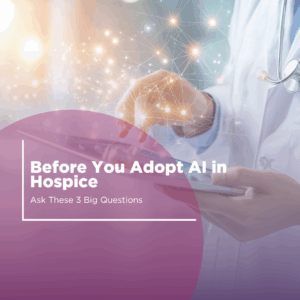Before You Adopt AI in Hospice, Ask These 3 Big Questions
Artificial intelligence (AI) is transforming healthcare. From voice-to-text documentation to predictive analytics, AI promises to streamline operations, reduce clinician burden, and improve outcomes. However, in hospice and palliative care, where care is deeply personal and the margin for error is razor thin, adopting AI cannot be treated as just another trend. It must be thoughtful, mission-aligned, and clinically appropriate.
Hospice leaders are under pressure. Staff shortages are real. Regulatory demands like Hospice HOPE are intensifying. Vendor inboxes are flooded with promises of automation, optimization, and return on investment (ROI). It is easy to feel like you must adopt AI quickly just to keep up.
But the truth is, not all AI is ready for hospice and palliative care. And not all hospice organizations are ready to implement it effectively. The stakes are too high to rush.
If your hospice or palliative care organization is exploring AI, here are three critical questions to ask before making a decision.
1. Is the AI built for the way hospice and palliative care work?
Hospice and palliative care are fundamentally different from other healthcare environments. The workflows are interdisciplinary. Much of the documentation relies on narrative detail. Clinicians manage complex emotional, spiritual, and medical needs at the same time. Care is not episodic or transactional. It is longitudinal, values-driven, and highly individualized.
Many AI tools on the market today were built for hospitals or outpatient clinics. They may offer efficiencies in acute care but fail in hospice because they do not understand the subtleties of team-based care, psychosocial documentation, or end-of-life symptom management.
Ask the vendor: Has your AI been developed specifically for hospice or palliative care? Or are you expecting our team to adapt to your tool?
Some hospices have tried generic AI dictation tools and found them inadequate. They could not capture the nuance of hospice documentation, especially when it comes to describing spiritual distress, family dynamics, or legacy work. Other teams tried predictive tools that produced frequent, non-actionable alerts that distracted the clinical team and created more work, not less.
Hospice AI must be purpose-built. It needs to support interdisciplinary team meetings, comply with documentation standards like HOPE, and align with Medicare Conditions of Participation. If the tool does not understand your workflow, it will only add friction.
2. Will this AI solution actually save time, or will it create more work?
AI should make your clinicians’ lives easier, not harder. Unfortunately, many solutions promise time savings but fail to deliver because they are poorly implemented or require too much manual oversight.
Here is where hidden costs show up. If your team needs to log into separate platforms, copy and paste information, or manually verify AI-generated content line by line, the benefits quickly disappear. Add in the time it takes to train staff, troubleshoot bugs, and manage updates, and you might find you are investing more time than you are saving.
Ask the vendor: What does your implementation and training process look like? What kind of support do you provide after go-live?
Responsible AI vendors should provide more than software. They should offer a clear rollout plan with defined milestones, retraining sessions for staff turnover, and a roadmap for future enhancements. Without this, even the most impressive AI tool will fail to achieve meaningful ROI.
You also want to ensure that your team can trust the AI. If it produces content that needs to be heavily edited or raises questions about accuracy, clinicians will disengage. The best AI makes documentation feel intuitive, not burdensome.
Ultimately, the right solution should reduce charting time, improve documentation quality, and give your clinicians more time for direct patient care. Do not just ask what the AI can do. Ask what the experience of using it will be like for your team on day one, day 30, and day 365.
3. Does the AI preserve your mission and center the patient?
This is perhaps the most important question of all. Hospice care is defined by its human connection. Patients and families count on your team to be present, compassionate, and attentive during the most vulnerable moments of life. Any technology you introduce must uphold that standard.
Ask yourself: Does this tool enhance our ability to serve patients meaningfully? Or does it get in the way?
AI should never replace the clinician’s presence. It should support that presence by taking on administrative tasks, summarizing clinical notes, or preparing IDG summaries. It should make care feel more personal, not less.
There is a real risk in adopting tools that do not align with your mission. Some AI solutions are focused solely on efficiency. Others may depersonalize care by reducing complex human experiences into checkboxes or canned phrases. If the technology distances your team from the bedside, it is not the right fit.
Ethical, mission-aligned AI empowers your team. It helps clinicians spend less time documenting and more time connecting. It supports spiritual care providers in crafting better notes. It assists social workers in capturing family dynamics. And it helps the entire team stay informed without increasing their cognitive load.
Conclusion: Thoughtful Evaluation and The Right Questions Make All the Difference
The conversation about AI in hospice and palliative care is just beginning. There is enormous potential to reduce burnout, improve quality, and strengthen compliance. But realizing that potential requires more than excitement. It requires asking the right questions, involving the right stakeholders, and choosing tools that are built for this environment.
Before you adopt AI, pause and evaluate:
- Is this solution designed for how we deliver care?
- Will this save time or increase workload?
- Does this align with our mission and center the patient?
If you can answer yes to all three, then you are on the path to responsible, effective AI adoption.
Hospice and palliative care deserve nothing less.




